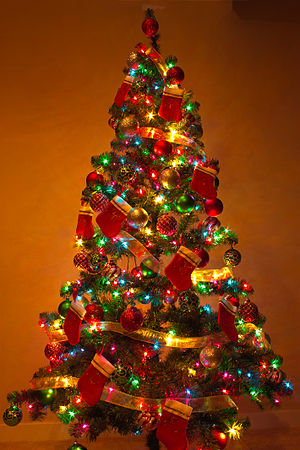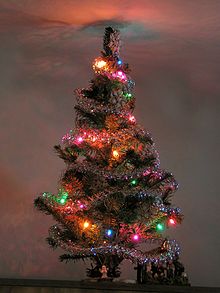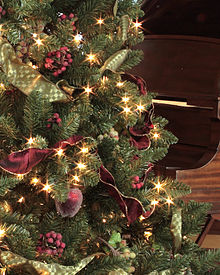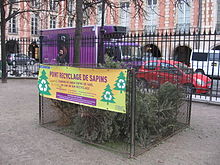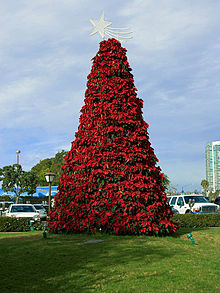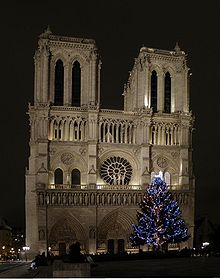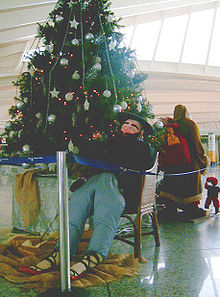- Christmas tree
-
The Christmas tree, also known as a Yule tree, is a decorated evergreen coniferous tree, real or artificial, and a tradition associated with the celebration of Christmas. The tradition of decorating an evergreen tree at Christmas started in Livonia and Germany in the 16th century.[2][3] The Christmas tree is traditionally brought into the home and decorated with Christmas lights (originally candles), ornaments, garlands, tinsel, and candy canes during the days around Christmas. An angel or star is placed at the top of the tree, representing the host of angels or the Star of Bethlehem from the Nativity.
Contents
History
Origin
Legend associates the first Christmas tree with St. Boniface and the German town of Geismar. Sometime in Boniface's lifetime (c. 672-754) he is said to have cut down the sacred tree of Thor in Geismar, replacing it with a fir tree which has been said to have been the first Christmas tree.[4] The word Tannenbaum, a German word for "fir tree", can be understood to be a "Christmas tree" although the literal meaning of "Christmas tree" is encapsulated in the word "Weihnachtsbaum."
The custom of erecting a Christmas tree can be historically traced to 15th century Livonia (present-day Estonia and Latvia) and 16th century Northern Germany. According to the first documented uses of a Christmas tree in Estonia, in 1441, 1442, and 1514 the Brotherhood of Blackheads erected a tree for the holidays in their brotherhood house in Reval (now Tallinn). At the last night of the celebrations leading up to the holidays, the tree was taken to the Town Hall Square where the members of the brotherhood danced around it.[5] In 1584, the pastor and chronicler Balthasar Russow wrote of an established tradition of setting up a decorated spruce at the market square where the young men “went with a flock of maidens and women, first sang and danced there and then set the tree aflame”.[2] In that period, the guilds started erecting Christmas trees in front of their guildhalls: Ingeborg Weber-Kellermann (Marburg professor of European ethnology) found a Bremen guild chronicle of 1570 which reports how a small tree was decorated with "apples, nuts, dates, pretzels and paper flowers" and erected in the guild-house, for the benefit of the guild members' children, who collected the dainties on Christmas Day.[3]
18th and 19th centuries
By the early 18th century, the custom had become common in towns of the upper Rhineland, but it had not yet spread to rural areas. Wax candles are attested from the late 18th century. The Christmas tree remained confined to the upper Rhineland for a relatively long time. It was regarded as a Protestant custom by the Roman Catholic majority along the lower Rhine and was spread there only by Prussian officials who were moved there in the wake of the Congress of Vienna in 1815.
The tradition was introduced to Canada in the winter of 1781 by Brunswick soldiers stationed in the Province of Quebec to garrison the colony against American attack. General Friedrich Adolf Riedesel and his wife, the Baroness von Riedesel, held a Christmas party at Sorel, delighting their guests with a fir tree decorated with candles and fruits.[6]
In the early 19th century, the custom became popular among the nobility and spread to royal courts as far as Russia. Princess Henrietta of Nassau-Weilburg introduced the Christmas tree to Vienna in 1816, and the custom spread across Austria in the following years. In France, the first Christmas tree was introduced in 1840 by the duchesse d'Orléans. In Denmark the first attested Christmas tree was lit in 1808 by countess Wilhemine of Holsteinborg. It was the aging countess who told the story of the first Danish Christmas tree to the Danish writer Hans Christian Andersen in 1865. He had published a fairy-tale called The Fir-Tree in 1844, recounting the fate of a fir-tree being used as a Christmas tree.[7]
The Queen's Christmas tree at Windsor Castle published in the Illustrated London News, 1848, and republished in Godey's Lady's Book, Philadelphia in December 1850.
In Britain, the Christmas tree was introduced in the time of the personal union with Hanover, by George III's Queen Charlotte of Mecklenburg-Strelitz in early 19th century, but the custom hadn't yet spread much beyond the royal family. Queen Victoria as a child was familiar with the custom and a tree was placed in her room every Christmas. In her journal for Christmas Eve 1832, the delighted 13-year-old princess wrote, "After dinner… we then went into the drawing-room near the dining-room… There were two large round tables on which were placed two trees hung with lights and sugar ornaments. All the presents being placed round the trees…"[8] After her marriage to her German cousin Prince Albert, by 1841 the custom became even more widespread throughout Britain.[9] In 1847, Prince Albert wrote: "I must now seek in the children an echo of what Ernest [his brother] and I were in the old time, of what we felt and thought; and their delight in the Christmas-trees is not less than ours used to be".[10]
A woodcut of the British Royal family with their Christmas tree at Windsor Castle, initially published in the Illustrated London News December 1848, was copied in the United States at Christmas 1850, in Godey's Lady's Book (illustration, left). Godey's copied it exactly, except for the removal of the Queen's tiara and Prince Albert's mustache, to remake the engraving into an American scene.[11] The republished Godey's image became the first widely circulated picture of a decorated evergreen Christmas tree in America. Art historian Karal Ann Marling called Prince Albert and Queen Victoria, shorn of their royal trappings, "the first influential American Christmas tree".[12] Folk-culture historian Alfred Lewis Shoemaker states, "In all of America there was no more important medium in spreading the Christmas tree in the decade 1850-60 than Godey's Lady's Book". The image was reprinted in 1860, and by the 1870s, putting up a Christmas tree had become common in America.[11]
Several cities in the United States with German connections lay claim to that country's first Christmas tree: Windsor Locks, Connecticut, claims that a Hessian soldier put up a Christmas tree in 1777 while imprisoned at the Noden-Reed House, while the "First Christmas Tree in America" is also claimed by Easton, Pennsylvania, where German settlers purportedly erected a Christmas tree in 1816 and In his diary, Matthew Zahm of Lancaster, Pennsylvania, recorded the use of a Christmas tree in 1821, leading Lancaster to also lay claim to the first Christmas tree in America.[13] Other accounts credit Charles Follen, a German immigrant to Boston, for being the first to introduce to America the custom of decorating a Christmas tree.[14] August Imgard, a German immigrant living in Wooster, Ohio, is the first to popularise the practice of decorating a tree with candy canes. In 1847, Imgard cut a blue spruce tree from a woods outside town, had the Wooster village tinsmith construct a star, and placed the tree in his house, decorating it with paper ornaments and candy canes. The National Confectioners' Association officially recognises Imgard as the first ever to put candy canes on a Christmas tree; the canes were all-white, with no red stripes. Imgard is buried in the Wooster Cemetery, and every year, a large pine tree above his grave is lit with Christmas lights. German immigrant Charles Minnegerode accepted a position as a professor of humanities at the College of William and Mary in Williamsburg in 1842, where he taught Latin and Greek. Entering into the social life of the Virginia Tidewater, Minnigerode introduced the German custom of decorating an evergreen tree at Christmas at the home of law professor St. George Tucker, thereby becoming another of many influences that prompted Americans to adopt the practice at about that time.[15]
20th century
Many cities, towns, and department stores put up public Christmas trees outdoors, such as the Rich's Great Tree in Atlanta, the Rockefeller Center Christmas Tree in New York City and the large Christmas tree at Victoria Square in Adelaide. During most of the 1970s and 1980s, the largest decorated Christmas tree in the world was put up every year on the property of The National Enquirer in Lantana, Florida. This tradition grew into one of the most spectacular and celebrated events in the history of southern Florida, but was discontinued on the death of the paper's founder in the late 1980s.[16]
In some cities, a Festival of Trees is organized around the decoration and display of multiple trees as charity events. In some cases the trees represent special commemorative gifts, such as in Trafalgar Square in London, where the City of Oslo, Norway presents a tree to the people of London as a token of appreciation for the British support of Norwegian resistance during the Second World War; in Boston, where the tree is a gift from the province of Nova Scotia, in thanks for rapid deployment of supplies and rescuers to the 1917 ammunition ship explosion that levelled the city of Halifax; and in Newcastle upon Tyne, where the 15 m-tall main civic Christmas tree is an annual gift from the city of Bergen, Norway, in thanks for the part played by soldiers from Newcastle in liberating Bergen from Nazi occupation.[17] Norway also annually gifts a Christmas tree to Washington D.C. as a symbol of friendship between Norway and the US and as an expression of gratitude from Norway for the help received from the US during World War II.[18]
The United States' National Christmas Tree is lit each year on the South Lawn of the White House. Today, the lighting of the National Christmas Tree is part of what has become a major holiday event at the White House. President Jimmy Carter lit only the crowning star atop the Tree in 1979 in honour of the Americans being held hostage in Iran.[19] The same was true in 1980, except the tree was fully lit for 417 seconds, one second for each day the hostages had been in captivity.[19]
The term Charlie Brown Christmas tree is used in the United States and Canada to describe any poor-looking or malformed little tree. Some tree buyers intentionally adopt such trees, feeling sympathetic to their plights. The term comes from the appearance of Charlie Brown's Christmas tree in the TV special A Charlie Brown Christmas.
In New Zealand, Pōhutukawa trees are described as "native Christmas trees", as they bloom at Christmas time, and look like Christmas trees with their red flowers and green foliage.
In Russia, the Christmas tree was banned shortly after the October Revolution but then reinstated as a New-year fir-tree (Новогодняя ёлка) in 1935. It became a fully secular icon of the New year holiday, for example, the crowning star was regarded not as a symbol of Bethlehem Star, but as the Red Star. Decorations, such as figurines of airplanes, bicycles, space rockets, cosmonauts, and characters of Russian fairy tales, were produced. This tradition persists after the fall of the USSR, with the New Year holiday outweighting the Christmas (7 January) for a wide majority of Russian people[citation needed].
Dates
Both setting up and taking down a Christmas tree are associated with specific dates. Traditionally, Christmas trees were not brought in and decorated until Christmas Eve (24 December) or, in the traditions celebrating Christmas Eve rather than on the first of day of Christmas, the 23 December, and then removed the day after twelfth night (6 January); to have a tree up before or after these dates was even considered bad luck.
Many families in America will put up a Christmas tree soon after Thanksgiving and Christmas decorations can show up even earlier in retail stores. Some households in the U.S. do not put up the tree until the second week of December, and leave it up until the 6th of January (Epiphany). In Germany, traditionally the tree is put up on the 24th of December and taken down on the 7th of January, though many start one or two weeks earlier, and in Roman Catholic homes the tree may be kept until late January. In Australia, the Christmas tree is usually put up on the 1st of December[citation needed], which occurs about a week before the school summer holidays; except for South Australia, where most people put up their tree after the Adelaide Credit Union Christmas Pageant in late November[citation needed]. Some traditions suggest that Christmas trees may be kept up until no later than the 2nd of February, the feast of the Presentation of Jesus in the Temple (Candlemas), when the Christmas season effectively closes.[20] Superstitions say that it is a bad sign if Christmas greenery is not removed by Candle mas Eve.[21]]
Types of trees used
 A grower in Waterloo, Nova Scotia, prunes Balsam Fir trees in October. The tree must experience three frosts to stabilize the needles before cutting.
A grower in Waterloo, Nova Scotia, prunes Balsam Fir trees in October. The tree must experience three frosts to stabilize the needles before cutting.
Natural trees
The most commonly used species are fir (Abies), which have the benefit of not shedding their needles when they dry out, as well as retaining good foliage colour and scent; but species in other genera are also used.
In northern Europe most commonly used are:
- Norway Spruce Picea abies (the original tree, generally the cheapest)
- Silver Fir Abies alba
- Nordmann Fir Abies nordmanniana
- Noble Fir Abies procera
- Serbian Spruce Picea omorika
- Scots Pine Pinus sylvestris
- Stone Pine Pinus pinea (as small table-top trees)
- Swiss Pine Pinus cembra
In North America, Central America and South America most commonly used are:
- Douglas-fir Pseudotsuga menziesii
- Balsam Fir Abies balsamea
- Fraser Fir Abies fraseri
- Grand Fir Abies grandis
- Guatemalan Fir Abies guatemalensis
- Noble Fir Abies procera
- Red Fir Abies magnifica
- White Fir Abies concolor
- Pinyon Pine Pinus edulis
- Jeffrey Pine Pinus jeffreyi
- Scots Pine Pinus sylvestris
- Stone Pine Pinus pinea (as small table-top trees)
- Norfolk Island Pine Araucaria heterophylla
Several other species are used to a lesser extent. Less-traditional conifers are sometimes used, such as Giant Sequoia, Leyland Cypress, Monterey Cypress and Eastern Juniper. Various types of spruce tree are also used for Christmas trees (including the Blue Spruce and, less commonly, the White Spruce); but spruces (unlike firs) begin to lose their needles rapidly upon being cut, and spruce needles are often sharp, making decorating uncomfortable. Virginia Pine is still available on some tree farms in the southeastern United States, however its winter colour is faded. The long-needled Eastern White Pine is also used there, though it is an unpopular Christmas tree in most parts of the country, owing also to its faded winter coloration and limp branches, making decorating difficult with all but the lightest ornaments. Norfolk Island Pine is sometimes used, particularly in Oceania; and in Australia, some species of the genera Casuarina and Allocasuarina are also occasionally used as Christmas trees. But, by far, the most common tree is the Monterey Pine. Adenanthos sericeus or Albany Woolly Bush is commonly sold in southern Australia as a potted living Christmas tree. Hemlock species are generally considered unsuitable as Christmas trees due to their poor needle retention and inability to support the weight of lights and ornaments.
Some trees, frequently referred to as Living Christmas trees, are sold live with roots and soil, often from a nursery, to be stored at nurseries in planters or planted later outdoors and enjoyed (and often decorated) for years or decades. Others are produced in a container and sometimes as topiary for a porch or patio. However, when done improperly, the combination of root loss caused by digging, and the indoor environment of high temperature and low humidity is very detrimental to the tree's health; additionally, the warmth of an indoor climate will bring the tree out of its natural winter dormancy, leaving it little protection when put back outside into a cold outdoor climate. Often Christmas trees are a large attraction for living animals, including mice and spiders. Thus, the survival rate of these trees is low.[22] However, replanting when done properly provides higher survival rates.[23]
European tradition prefers the open aspect of naturally-grown, unsheared trees, while in North America (outside western areas where trees are often wild-harvested on public lands[24]) there is a preference for close-sheared trees with denser foliage, but less space to hang decorations.
In the past, Christmas trees were often harvested from wild forests, but now almost all are commercially grown on tree farms. Almost all Christmas trees in the United States are grown on Christmas tree farms where they are cut after about ten years of growth and new trees planted. According to the United States Department of Agriculture (USDA) agriculture census for 2002 (the census is done every five years), 21,904 farms were producing conifers for the cut Christmas tree market in America, 180,897 hectares (447,006 acres) were planted in Christmas trees, and 13,849 farms harvested cut trees. The top 5 percent of the farms (40 hectares / 100 acres or more) sold 61 percent of the trees. The top 26 percent of the farms (8 hectares / 20 acres or more) sold 84 percent of the trees. Farms less than 0.8 hectare (two acres) comprised 21 percent of the farms, and sold an average of 115 trees per farm.[25]
The life cycle of a Christmas tree from the seed to a 2-metre (7 ft) tree takes, depending on species and treatment in cultivation, between 8 and 12 years. First, the seed is extracted from cones harvested from older trees. These seeds are then usually grown in nurseries and then sold to Christmas tree farms at an age of 3–4 years. The remaining development of the tree greatly depends on the climate, soil quality, as well as the cultivation and tendance by the Christmas tree farmer.[26]
Artificial trees
Main article: Artificial Christmas treesThe first artificial Christmas trees were developed in Germany during the 19th century,[27][28] though earlier examples exist.[29] These "trees" were made using goose feathers that were dyed green.[27] The German feather trees were one response by Germans to continued deforestation in Germany.[28] Feather Christmas trees ranged widely in size, from a small 2-inch (51 mm) tree to a large 98-inch (2,500 mm) tree sold in department stores during the 1920s.[30] Often, the tree branches were tipped with artificial red berries which acted as candle holders.[31]
Over the years, other styles of artificial Christmas trees have evolved and become popular. In 1930, the U.S.-based Addis Brush Company created the first artificial Christmas tree made from brush bristles.[32] Another type of tree, the aluminum Christmas tree, is made from aluminum.[28] The trees were manufactured in the United States, first in Chicago in 1958,[33] and later in Manitowoc, Wisconsin, where the majority of the trees were produced.[34]
 Evolution of Artificial Christmas Trees to adapt to changing modern styles and trends.
Evolution of Artificial Christmas Trees to adapt to changing modern styles and trends.
Most modern artificial Christmas trees are made from 100% recycled plastics of used packaging materials, such as polyvinyl chloride (PVC) or other plastics.[28] Approximately 10% of artificial Christmas trees are using virgin suspension PVC resin and despite being plastic most artificial trees are not recyclable or biodegradable.[35]
Other gimmicks have developed as well. Fiber optic Christmas trees come in two major varieties, one resembles a traditional Christmas tree.[36] One Dallas-based company offers "holographic mylar" trees in many hues.[29] Tree-shaped objects made from such materials as cardboard,[37] glass,[38] ceramic or other materials can be found in use as tabletop decorations. Upside-down artificial Christmas trees became popular for a short time and were originally introduced as a marketing gimmick; they allowed consumers to get closer to ornaments for sale in retail stores and opened up floor space for more products.[39]
Artificial trees became increasingly popular during the late 20th century.[28] Users of artificial Christmas trees assert that they are more convenient, and, because they are reusable, much cheaper than their natural alternative.[28] Between 2001 and 2007 artificial Christmas tree sales in the U.S. jumped from 7.3 million to 17.4 million.[40]
Environmental issues
Artificial
The debate about the environmental impact of artificial trees is ongoing. Generally, natural tree growers contend that artificial trees are more environmentally harmful than their natural counterpart.[40] On the other side of the debate, trade groups such as the American Christmas Tree Association, continue to refute that artificial trees are more harmful to the environment and maintain that the PVC used in Christmas trees has excellent recyclable properties.[41] In the past, lead was often used as a stabilizer in PVC, but is now banned by Chinese laws. Most trees are made of recycled PVC rigid sheets using Tin stabilizer in the recent years. Its use of Lead stabilizer in the old Chinese imported trees has been an issue of concern among politicians and scientists over recent years. A 2004 study found that while in general artificial trees pose little health risk from lead contamination, there do exist "worst-case scenarios" where major health risks to young children exist.[42] Another report, this time a 2008 U.S. Environmental Protection Agency report, found that as the PVC in artificial Christmas trees aged it began to degrade.[43] The report determined that of the 50 million artificial trees in the United States approximately 20 million were 9 or more years old, the point where dangerous lead contamination levels are reached.[43] A professional study on the Life Cycle Assessment (LCA) of both real and fake Christmas trees revealed that one must use its artificial Christmas tree at least during 20 years to leave an environmental footprint as small as the natural Christmas tree.[44]
A small amount of real-tree material is used in some artificial trees. For instance, the bark of a real tree can be used to surface an artificial trunk.[45]
Natural
Natural Christmas trees on the other hand are entirely biodegradable and are generally disposed of in landfills.
Real or Cut trees are used only for a short time, but can be recycled and used as mulch or used to prevent erosion.[46] Real trees are carbon-neutral, they emit no more carbon dioxide by being cut down and disposed of than they absorb while growing.[47] An independent Life Cycle Assessment (LCA) study, conducted by a firm of experts in sustainable development, states that a natural tree will generate 3.1 kg of greenhouse gases every year (based on purchasing 5 km from home) whereas the artificial tree will produce 48.3 kg over its lifetime.[44] Some people use Living Christmas or potted trees for several seasons, providing a longer life cycle for each tree. Living Christmas trees can be purchased or rented in by local market growers. Rentals are picked up after the holidays, while purchased trees can be planted by the owner after use or donated to local tree adoption/urban reforestation services.[48]
Live trees are typically grown as a crop and replanted in rotation after cutting, often providing suitable habitat for wildlife.[citation needed] In some cases management of Christmas tree crops can result in poor habitat since it sometimes involves heavy input of pesticides.[citation needed]
Concerns have been raised about people cutting down old and rare conifers, such as the Keteleeria evelyniana, for Christmas trees.
Decoration and ornaments
Tree trimming decorations
Tinsel and several types of garland or ribbon are commonly used to decorate a Christmas tree. Delicate mould-blown and painted coloured glass Christmas ornaments were a speciality of the glass factories in the Thuringian Forest especially in Lauscha in the late 19th century, and have since become a large industry, complete with famous-name designers. Lighting with candles or electric lights (fairy lights) is commonly done and a tree topper, traditionally either an angel or a star, completes the ensemble.
Silvered saran based tinsel was introduced later, although its inability to drape as well as metal tinsel led to the demise of tinsel in tree decorating in the United States (it remains popular in European countries). Baubles are another common decoration, consisting of small hollow glass or plastic spheres coated with a thin metallic layer to make them reflective, with a further coating of a thin pigmented polymer in order to provide colouration.
Individuals' decorations typically include a mix of family traditions and personal tastes; even a small unattractive ornament, if passed down from a parent or grandparent, may come to carry considerable emotional value and be given a place of pride on the tree. Conversely, trees decorated by professional designers for department stores and other institutions will usually have a "theme"; a set of predominant colours, multiple instances of each type of ornament, and larger decorations that may be more complicated to set up correctly. Some churches decorate with Chrismon trees, which use handmade ornaments depicting various Chrismon symbols.
Many people also decorate outdoor trees with food that birds and other wildlife will enjoy, such as garlands made from unsalted popcorn or cranberries, orange halves, and seed-covered suet cakes.
Tree mats and skirts
Since candles were used to light trees until electric bulbs came about, a mat (UK) or skirt (US) was often placed on the floor below the tree to protect it by catching the dripping candle wax, and also to collect any needles that fall. Even when dripless candles, electric lights and artificial trees have been used, a skirt is still usually used as a decorative feature: among other things, it hides the Christmas tree stand, which may be unsightly but which is an important safety feature of home trees. What began as ordinary cloth has now often become much more ornate, some having embroidery or being put together like a quilt.
A nativity scene, model train, or Christmas village may be placed on the mat or skirt. As Christmas presents arrive, they are generally placed underneath the tree on the tree skirt (depending on tradition, all Christmas gifts, or those too large to be hung on the tree, as in "presents on the tree" of the song "I'll Be Home for Christmas").
Generally, the difference between a mat and skirt is simply that a mat is placed under the Christmas tree stand, while a skirt is placed over it, having a hole in the middle for the trunk, with a slot cut to the outside edge so that it can be placed around the tree (beneath the branches) easily. A plain mat of fabric or plastic may also be placed under the stand and skirt to protect the floor from scratches or water.
Christmas tree stand
A Christmas tree stand is an object designed to support a cut, natural Christmas tree or an artificial Christmas tree. Christmas tree stands appeared as early as 1876 and have had various designs over the years. Those stands designed for natural trees have a water reservoir to hydrate the live tree. Artificial Christmas trees usually have a plastic or metal stand, with 3 legs shaping like a Y.
Flocking
In the 1940s and 1950s flocking was very popular on the West Coast of the United States. There were home flocking kits that could be used with vacuum cleaners. In the 1980s some trees were sprayed with fluffy white flocking to simulate snow. Typically it would be sprayed all over the tree from the sides, which produced a look different from real snow, which settles in clumps atop branches. Flocking can be done with a professional sprayer at a tree lot (or the manufacturer if it is artificial), or at home from a spray can, and either can be rather messy. This tradition seems to be most popular on the West Coast and Southern parts of the United States.
Because flock contains flame retardants, a flocked tree can be placed in a public building in accordance with local fire codes.
In the late 1800s and, most probably, long before, home-made white Christmas trees were made by wrapping strips of cotton batting around leafless branches creating the appearance of a snow-laden tree. This family tradition eliminated killing and care of a live tree and needle drop in the house while providing a beautiful way of displaying ornaments. After Christmas, the cotton batting was unwrapped and stored with the Christmas presents and the branches were burnt or discarded. It is thought these home-made white trees at least, in part, inspired flocking popularized by Hollywood films in the late 1930s.
Controversy
The Christmas tree has seen an amount of controversy, mainly involving separation of church and state, the secular and non-secular usage of the tree as well as groups who oppose usage of the tree on the grounds of interpretation of scripture and pagan origins or pagan character of the custom.
In 2005, the Seattle-Tacoma International Airport removed all of its Christmas trees in the middle of the night rather than allow a rabbi to put up a menorah near the largest tree display.[49] Officials feared that one display would open the door for other religious displays,[49] and, in 2006, they opted to display a grove of birches in polyethylene terephthalate snow rather than religious symbols or Christmas trees.[49]
In 2005, the city of Boston renamed the spruce tree used to decorate the Boston Common a "Holiday Tree" rather than a "Christmas Tree".[50] The name change drew a poor response from the public and was changed back to "Christmas Tree" after being threatened with several lawsuits by Rev. Jerry Falwell and the Alliance Defense Fund. In the same year, Speaker of the House, Dennis Hastert, R-Ill., asked that the tree that decorates the Capitol grounds to be renamed back to "Christmas tree". It had been renamed "Holiday tree" in the 1990s.[51]
Christianity
Jeremiah 10:1-5 in the Bible says the following (King James Version):
[1] Hear what the Lord says to you , O house of Israel. [2] This is what the Lord says: "Do not learn the ways of the nations or be terrified by signs in the sky, though the nations are terrified by them. [3] For the customs of the peoples are worthless; they cut a tree out of the forest, and a craftsman shapes it with his chisel. [4] They adorn it with silver and gold; they fasten it with hammer and nails so it will not totter. [5] Like a scarecrow in a melon patch, their idols cannot speak; they must be carried because they cannot walk. Do not fear them; they can do no harm nor can they do any good."
This is interpreted by some fundamentalist Christians as referring to a Christmas tree, and that therefore the Bible would explicitly forbid the practice. Others feel that since "Christmas Trees" are not biblically ordained, they should not be used. The original celebration of Christmas was the birth of Christ.
Also, Isaiah 55:13, refers to the evergreen tree as a joyful sign to the Lord in celebration of life everlasting, that shall not be cut off, though some apologists feel this is saying that the Messiah will live forever just like an evergreen tree never dies, (it doesn't lose its leaves when Autumn comes).
Some churches however use Christmas trees as decoration at Christmas time. Others use the same stripped Christmas tree as a Christian cross at Easter.[citation needed] See the poem The Dream of the Rood. Both Ezekiel 47:12 and the Book of Revelation 22:2 use trees as a symbol of new fruitful life, compared to the Tree of life denied Adam in Genesis 3:22-23. Paul makes the link between Adam and Christ clear in Romans chapter 5:
Adam is a type of the one who was to come. (v. 14)
The idea of a link between Christ and the Tree of Life is also of great antiquity. Hippolytus of Rome writes in the 3rd century:
The fruit of righteousness and the tree of life is Christ. He alone, as man, fulfilled all righteousness. And with His own underived life He has brought forth the fruits of knowledge and virtue like a tree, whereof they that eat shall receive eternal life, and shall enjoy the tree of life in paradise, with Adam and all the righteous.[52]
In some Catholic countries, the tree is seen as a recent Protestant or American influence detracting from the Mediterranean traditions of the Christmas crib.[citation needed] However in many Catholic homes, both types of decoration coexist.
Industry
Each year, 33 to 36 million Christmas trees are produced in America, and 50 to 60 million are produced in Europe. In 1998, there were about 15,000 growers in America (a third of them "choose and cut" farms). In that same year, it was estimated that Americans spent $1.5 billion on Christmas trees.[53]
See also
- Chrismon tree
- Festive ecology
- Festivus Pole
- Hanukkah bush
- Holiday tree
- New Year tree
- Star of Bethlehem
- Tree (mythology)
- Weihnachten
- Yule log
References
- ^ http://www.flickr.com/photos/yatharthgupta/5284146557/in/photostream/ Christmas Tree with Ornaments
- ^ a b Balthasar Russow. 1584. Chronica der Provinz Lyfflandt.
- ^ a b Ingeborg Weber-Kellermann, Das Weihnachtsfest. Eine Kultur- und Sozialgeschichte der Weihnachtszeit, Luzern [u. a.] 1978, ISBN 3-7658-0273-5
- ^ Littleton, C. Scott (2005). Gods, Goddesses, and Mythology, Volume 4. Marshall Cavendish Corporation. p. 559. ISBN 978-0761475590. http://books.google.co.uk/books?id=n2FpRCam224C&pg=PA559&dq=Christmas+tree++.+Boniface+Thor&hl=en&ei=jdMqTczDFobLhAep-s3-Cg&sa=X&oi=book_result&ct=result&resnum=3&ved=0CC0Q6AEwAjgo#v=onepage&q=Christmas%20tree%20%20.%20Boniface%20Thor&f=false.
- ^ Friedrich Amelung, Geschichte der Revaler Schwarzenhäupter: von ihrem Ursprung an bis auf die Gegenwart: nach den urkundenmäßigen Quellen des Revaler Schwarzenhäupter-Archivs 1, Die erste Blütezeit von 1399–1557. Reval: Wassermann, 1885.
- ^ Chartrand (2004), p. 311
- ^ Kristelig Dagblad, "Danmarks første juletræ blev tændt i 1808", December 17 2008
- ^ The girlhood of Queen Victoria: a selection from Her Majesty's diaries. p. 61. Longmans, Green & co., 1912. University of Wisconsin Press.
- ^ Lejeune, Marie Claire. Compendium of symbolic and ritual plants in Europe. p. 550. University of Michigan ISBN 9077135049
- ^ The Prince Consort: man of many facets: the world and the age of Prince Albert. p. 78 Oresko Books, 1977.
- ^ a b Shoemaker, Alfred Lewis. (1959) Christmas in Pennsylvania: a folk-cultural study. Edition 40. p.52,53. Stackpole Books 1999. ISBN 0811703282
- ^ Marling, Karal Ann. (2000) Merry Christmas! celebrating America's greatest holiday. P.4. p.244. Harvard University Press ISBN 0674003187
- ^ "The History of Christmas". Gareth Marples. http://www.thehistoryof.net/the-history-of-christmas.html. Retrieved December 2, 2006.
- ^ Professor Brought Christmas Tree to New England
- ^ Encyclopediavirginia.org
- ^ "Flashback Blog 'The World's Largest Decorated Christmas Tree'". Palm Beach Post. December 3, 2009. http://www.historicpalmbeach.com/flashback/2009/12/the-worlds-largest-decorated-christmas-tree. Retrieved 2010-03-04.
- ^ Newcastle City Council Town twinning: Bergen, Norway
- ^ "Norwegian Christmas at Union Station: Tree Lighting Ceremony and Concert". Norwegian Ministry of Foreign Affairs (Norway.org). 25 November 2008. http://www.norway.org/xmas/signatureevents/TreeLightingCeremony.htm. Retrieved 25 November 2008.[dead link]
- ^ a b "Lighting of the National Christmas Tree - History", President's Park - White House, nps.gov, accessed April 5, 2009.
- ^ Customs of the Weeks after Epiphany
- ^ Christmas Superstitions, December 2006
- ^ "Living Christmas Trees". Clemson University. http://www.clemson.edu/extension/hgic/plants/other/seasonal/hgic1751.html. Retrieved 2010-07-12.
- ^ For.msu.edu
- ^ US Bureau of Land Management: Christmas tree permits
- ^ US National Christmas Tree Association: Statistics
- ^ MK Weihnachtsbaumkulturen
- ^ a b Forbes, Bruce David. Christmas: A Candid History, (Google Books), University of California Press, 2007, pp. 121-22, (ISBN 0520251040)
- ^ a b c d e f Hewitt, pp. 33-36.
- ^ a b Perkins, Broderick. "Faux Christmas Tree Crop Yields Special Concerns", Realty Times, December 12, 2003, accessed December 21, 2008.
- ^ Silverthorne, Elizabeth. Christmas in Texas, (Google Books), Texas A&M University Press, 1994, p. 62, (ISBN 0890965781).
- ^ Marling, Karal Ann. Merry Christmas!: Celebrating America's Greatest Holiday, (Google Books), Harvard University Press, 2000, pp. 58-62, (ISBN 0674003187).
- ^ Cole, Peter, et al. Christmas Trees: Fun and Festive Ideas, (Google Books), Chronicle Books, 2002, p. 23, (ISBN 0811835774).
- ^ Fortin, Cassandra A. "It's beginning to look a lot like Christmas (1958)", The Baltimore Sun, October 26, 2008, accessed December 21, 2008.
- ^ Andrews, Candice Gaukel. Great Wisconsin Winter Weekends, (Google Books), Big Earth Publishing, 2006, p. 178, (ISBN 1931599718)
- ^ Berry, Jennifer. Fake Christmas Trees Not So Green", LiveScience.com, December 9, 2008, accessed December 21, 2008.
- ^ Neer, Katherine. "How Christmas Trees Work", howstuffworks.com, December 2006, accessed December 21, 2008.
- ^ "Table-top Christmas Tree", (Google Books), Popular Mechanics January 1937, p. 117.
- ^ "Glass Christmas Tree", Diablo Glass School, one-day course listing, accessed December 21, 2008.
- ^ "Demand Grows for Upside Down Christmas Tree", (Audio), National Public Radio, "All Things Considered", November 9, 2005, accessed December 21, 2008.
- ^ a b Hayes, Sharon Caskey. "Grower says real Christmas trees are better for environment than artificial ones", Kingsport Times-News (Kingsport, Tennessee), November 26, 2008, accessed December 21, 2008.
- ^ "Facts on PVC Used in Artificial Christmas Trees", American Christmas Tree Association, official site, accessed December 21, 2008.
- ^ Maas, Richard P. et al. Artificial Christmas trees: how real are the lead exposure risks? (Abstract via PubMed) Journal of Environmental Health, December 2004; 67(5): 20-4, 32, accessed December 21, 2008.
- ^ a b Levin, Ronnie, et al. "Lead Exposures in U.S. Children, 2008: Implications for Prevention", Environmental Health Perspective October 2008; 116(10): 1285–1293, accessed December 21, 2008.
- ^ a b Ellipsos Inc. "Life Cycle Assessment (LCA) of Christmas trees, A study ends the debate over which Christmas tree, natural or artificial, is most ecological", December 16, 2008; accessed online September 22, 2009.
- ^ Grist environmental commentary: Christmas trees
- ^ Engineer Update: Old Christmas trees protect town beach
- ^ Biello, David."I'm Dreaming of a Green Christmas (Tree)", Scientific American, transcript, podcast, December 4, 2008, accessed December 22, 2008.
- ^ Christmastree.org
- ^ a b c "Nativity to be Allowed in Capitol Rotunda: Lawsuit Settlement Calls for Fair Treatment for Christian Beliefs". WorldNetDaily.com, October 23, 2007.
- ^ "Boston's "Holiday Tree" Sparks Controversy". TheHarvardCrimson.com. 2005. http://www.thecrimson.com/article.aspx?ref=510132. Retrieved 2008-01-08.
- ^ At Christmas, what's in a name?: ABC report, November 2005
- ^ On Proverbs, From the Commentary of St. Hippolytus on Proverbs.
- ^ Chastagner, Gary A. and Benson, D. Michael (2000). "The Christmas Tree". Archived from the original on 2006-12-06. http://web.archive.org/web/20061206194229/http://apsnet.org/education/feature/1225tree/top.htm. Retrieved 2006-12-08.
Bibliographic
- Hewitt, James. The Christmas Tree, (Google Books), Lulu.com, 2007, (ISBN 1430308206).
External links
- Christmas trees at the Open Directory Project
- Christmas Tree Survives War, Hiroshima Bomb Associated Press - 21 December 2007
- Riga, Latvia purported home of the original Christmas Tree
- History of the Christmas Tree
Christmas trees Cultivation Production Artificial Artificial Christmas tree · Aluminum Christmas tree · Feather Christmas treeDecorations Candy cane · Christmas ornament · Christmas lights · Garland · Pleated Christmas hearts · Shiny Brite ornaments · Szaloncukor · Tinsel · Tree topperIndividual trees Boston · California Capitol · U.S. Capitol · Chicago · Grove (L.A.) · Lisbon (Portugal) · Macy's (Atlanta) · Milwaukee · Mount Ingino (Italy) · U.S. National Tree · Rockefeller Center · Trafalgar Square (London) · Vatican · White HouseTrade groups American Christmas Tree Association · British Christmas Tree Growers Association · Canadian Christmas Tree Growers Association · National Christmas Tree AssociationOther topics "Attack of the Mutant Artificial Christmas Trees" · Chrismon tree · Christmas tree stand · Festive ecology · Hanukkah bush · Holiday tree · Rouse Simmons · Singing Christmas Tree · Tree tyerCategories:- Christmas in Germany
- Christmas trees
- Christmas decorations
- Artificial Christmas trees
- Christmas traditions
- Holiday-related topics
- Seasonal traditions
Wikimedia Foundation. 2010.

